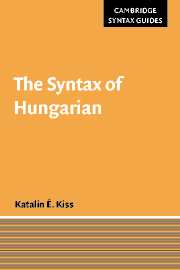Book contents
7 - The noun phrase
Published online by Cambridge University Press: 06 July 2010
Summary
The inner structures of the various types of verb complements resemble the inner structure of the extended verb phrase in their outlines: they consist of a lexical phrase embedded in morphosyntactic projections and operator projections. The noun phrase, too, will be analyzed as a complex containing a lexical kernel (the NP proper) subsumed by operator projections extending it into an indefinite numeral phrase (NumP) and/or a definite determiner phrase (DP). The full range of morphosyntactic projections that play a role in the noun phrase will become evident in the analysis of the possessive construction.
The basic syntactic layers of the noun phrase
The minimal noun projection appearing in the Hungarian sentence is a bare singular case-marked noun; for example:
(1) a. János könyvet olvas.
John book-ACC reads
‘John is book-reading.’
b. János moziba ment.
John cinema-to went
‘John went to (the) cinema.’
In the unmarked case such nouns function as verb modifiers. In Section 3.6 verb modifiers were shown to display both phrase-like and head-like properties: they move into Spec, AspP like a phrase, and merge with the V in Asp like a head, which suggests that they are both minimal and maximal, i.e., they are phrases containing merely a head.
- Type
- Chapter
- Information
- The Syntax of Hungarian , pp. 151 - 180Publisher: Cambridge University PressPrint publication year: 2002

